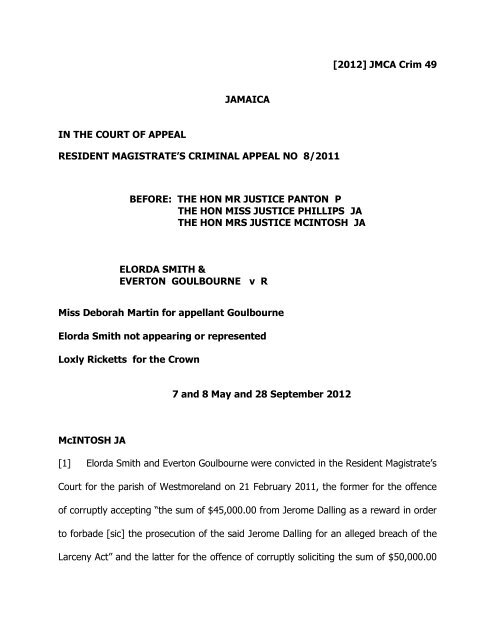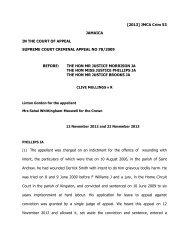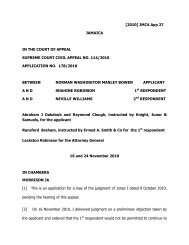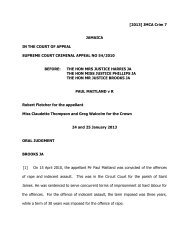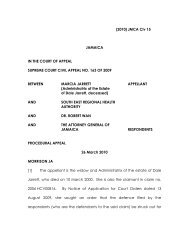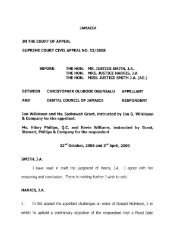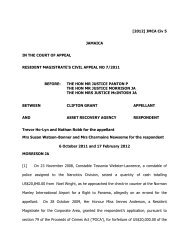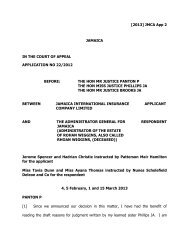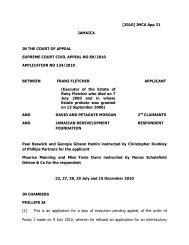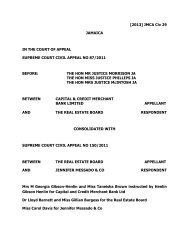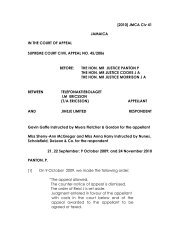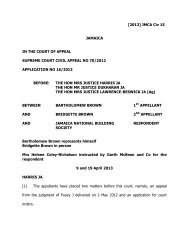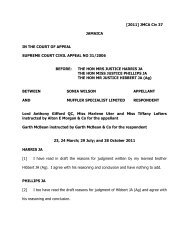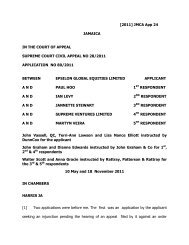Smith (Elorda) & Goulbourne (Everton) v R.pdf - The Court of Appeal
Smith (Elorda) & Goulbourne (Everton) v R.pdf - The Court of Appeal
Smith (Elorda) & Goulbourne (Everton) v R.pdf - The Court of Appeal
Create successful ePaper yourself
Turn your PDF publications into a flip-book with our unique Google optimized e-Paper software.
[2012] JMCA Crim 49JAMAICAIN THE COURT OF APPEALRESIDENT MAGISTRATE’S CRIMINAL APPEAL NO 8/2011BEFORE: THE HON MR JUSTICE PANTON PTHE HON MISS JUSTICE PHILLIPS JATHE HON MRS JUSTICE MCINTOSH JAELORDA SMITH &EVERTON GOULBOURNE v RMiss Deborah Martin for appellant <strong>Goulbourne</strong><strong>Elorda</strong> <strong>Smith</strong> not appearing or representedLoxly Ricketts for the Crown7 and 8 May and 28 September 2012McINTOSH JA[1] <strong>Elorda</strong> <strong>Smith</strong> and <strong>Everton</strong> <strong>Goulbourne</strong> were convicted in the Resident Magistrate’s<strong>Court</strong> for the parish <strong>of</strong> Westmoreland on 21 February 2011, the former for the <strong>of</strong>fence<strong>of</strong> corruptly accepting “the sum <strong>of</strong> $45,000.00 from Jerome Dalling as a reward in orderto forbade [sic] the prosecution <strong>of</strong> the said Jerome Dalling for an alleged breach <strong>of</strong> theLarceny Act” and the latter for the <strong>of</strong>fence <strong>of</strong> corruptly soliciting the sum <strong>of</strong> $50,000.00
from the said Jerome Dalling for the same purpose, contrary, in each case, to section14(1) <strong>of</strong> the Corruption Prevention Act (the Act). After the guilty verdicts were entered<strong>Elorda</strong> <strong>Smith</strong> was sentenced to pay a fine <strong>of</strong> $250,000.00 while <strong>Everton</strong> <strong>Goulbourne</strong>was sentenced to pay a fine <strong>of</strong> $200,000.00, each with an alternative <strong>of</strong> six monthsimprisonment at hard labour if the fines were not paid.[2] Both appellants filed notice and grounds <strong>of</strong> appeal on 25 February 2011challenging the learned Resident Magistrate’s decision. However, after filing his noticeand grounds <strong>of</strong> appeal, Mr <strong>Smith</strong> took no step in furtherance <strong>of</strong> his appeal.<strong>The</strong> prosecution’s case[3] Jerome Dalling (hereafter the complainant) gave evidence <strong>of</strong> an incident whichtook place, he said, between 1 April and 17 May 2007, at about 6:30 to 7:30 pm, inSavanna-la-mar, Westmoreland.He had parked his minibus on the roadway andeventually went into his aunt’s hairdressing shop on the said road, leaving a fewpassengers in the bus, one <strong>of</strong> whom was his girlfriend. While in the shop he observeda white jeep with the appellant and Mr <strong>Smith</strong> aboard. <strong>The</strong>y were known to him as police<strong>of</strong>ficers and he recognized the jeep they were travelling in as a government vehiclewhich he had seen before. Observing that it had stopped in front <strong>of</strong> his bus, thecomplainant said he left his aunt’s shop and walked towards the bus, whereupon hewas summoned by Mr <strong>Smith</strong> who remained seated in the jeep. <strong>The</strong> complainant saidMr <strong>Smith</strong> then questioned him about ownership <strong>of</strong> the bus and requested the vehicledocuments, which he produced.
[4] <strong>The</strong> complainant further testified that after Mr <strong>Smith</strong> perused the documents hehanded them to the appellant who then approached him and engaged him inconversation for about 15 minutes. <strong>The</strong> appellant told him that the licence plates onthe vehicle bore letters that had not yet been issued and indicated that the minibus wasgoing to be seized by the police. <strong>The</strong>reafter the appellant requested the keys for thevehicle and drove it away. According to the complainant Mr <strong>Smith</strong> then gave him theappellant’s cellular telephone number as well as his own number. <strong>The</strong> vehicledocuments were never returned to him.[5] Later that evening he went to the Savanna-la-mar Police Station and spoke to twopolice <strong>of</strong>ficers there concerning the matter but no statement was recorded from him.He said from the night <strong>of</strong> the incident and during the weeks that followed, heexchanged telephone calls with the appellant and with Mr <strong>Smith</strong>.He was able torecognize the voice <strong>of</strong> the appellant as he had heard it before and when it wassuggested to him in cross-examination that he did not know the appellant’s voice heresponded, “I know Mr <strong>Goulbourne</strong> very well. I know his voice. I speak to him face t<strong>of</strong>ace not only on the phone.” It was his testimony that during one <strong>of</strong> the telephoneconversations with the appellant he was told that he was facing 10 charges but whenhe asked what those charges were, the appellant did not respond. <strong>The</strong> complainantfurther testified that the appellant then requested payment <strong>of</strong> $50,000.00 to “drop thecharge” but he told the appellant that he did not have $50,000.00. This request wassubsequently pursued by Mr <strong>Smith</strong> in several telephone conversations with thecomplainant in which Mr <strong>Smith</strong> told him that time was running out for the payment <strong>of</strong>
the $50,000.00. Eventually, the complainant handed over the sum <strong>of</strong> $45,000.00 to Mr<strong>Smith</strong> and later made a report at the police Anti-Corruption Branch in Kingston.[6] Among the other witnesses called by the prosecution was the investigating<strong>of</strong>ficer, Sergeant Redway, who gave evidence <strong>of</strong> the requirement to make entries in theappropriate station diaries and property registers by <strong>of</strong>ficers involved in the recovery <strong>of</strong>stolen vehicles or seizure <strong>of</strong> vehicles. He testified that in the instant case, there was anentry in the station diary at the Frome Police Station (exhibit 2) to the effect that: (i)the minibus was examined by forensic experts and confirmed to be a vehicle reportedstolen on 15 June 2006; (ii) it was recovered on 2 April 2007 and (iii) it was handedover, at the request <strong>of</strong> an insurance company, to its insured.<strong>The</strong> case for the defence[7] At the close <strong>of</strong> the prosecution’s case the attorney who then represented theappellant <strong>Goulbourne</strong> unsuccessfully submitted that the prosecution had failed to makeout a prima facie case against him and the appellant was called upon to answer thecharge. He elected to give evidence on oath in which he confirmed his participation inthe seizure <strong>of</strong> the complainant’s minibus, sometime in April <strong>of</strong> 2007. However, hedenied having any subsequent conversations with the complainant and produced copytelephone bills for his cellular telephone service during the period April and May 2007 asevidence that no calls were made from his cell phone to the complainant’s cell phone asalleged. <strong>The</strong> appellant also testified that he had no discussions with his co-accused<strong>Elorda</strong> <strong>Smith</strong> about collecting money from the complainant.
[8] <strong>The</strong> prosecution objected to the attempt by the appellant’s attorney to have thecopy documents admitted into evidence on the basis that there was no evidence as totheir authenticity and there was the possibility that they might have been subjected totampering.However, although disagreeing with defence attorney’s submission thatthey were admissible as an exception to the hearsay rule, the learned ResidentMagistrate nevertheless admitted the copy documents as exhibit 7. <strong>The</strong>se documentswere later shown to the complainant who admitted that he did not see recorded onthem any calls being placed to his cell phone from the appellant’s cell phone.[9] In cross-examination the appellant said he learnt that the minibus was reportedlya stolen vehicle 13 days after its seizure but took no steps to contact the complainant inthis regard. He also testified that he had made no entry in the station diary either atthe Frome or the Savannah-la-mar police stations concerning the seizure <strong>of</strong> theminibus. He thought that Mr <strong>Smith</strong> had done so.<strong>The</strong> grounds <strong>of</strong> appeal[10] <strong>The</strong> appellant filed a total <strong>of</strong> 11 supplemental grounds <strong>of</strong> appeal on 2 May 2012and these formed the basis <strong>of</strong> the arguments advanced on his behalf. <strong>The</strong>y are set outbelow in their entirety.“1. That the Learned Resident Magistrate (LRM) erred in notupholding the No Case Submission made on behalf <strong>of</strong> theAppellant: -<strong>The</strong> submissions were that:-
(i) the evidence <strong>of</strong> the Complainant had not met anacceptable threshold to form the basis for voiceidentification,(ii) the contradiction in the evidence between what theComplainant said and the telephone records was such thatthe Complainant was so manifestly discredited that theAppellant ought not to have been called upon to answerto the charge.2. That the LRM erred when she found as a fact, having regardto the evidence, that the Appellant departed from his dutywhen he failed to charge the Complainant or return themotor vehicle in circumstances where there wasuncontradicted evidence that:-(i)(ii)the vehicle had been given to the legal owner BCIC,that the Complainant for the larceny had no interest inpursuing the criminal matter or,(iii) that the Complainant Dalling was not considered asuspect to the larceny or receiving <strong>of</strong> the vehicle.3. That the LRM erred when she found as a basis for rejecting theadmission <strong>of</strong> Dalling that he did not see his phone numberson the copy bills presented to him, that ‘calls to <strong>Goulbourne</strong>were on a private number’ (see pg. 130 <strong>of</strong> the record). Thatthe evidence <strong>of</strong> the Complainant was that numerous callswere placed to and from the Appellant's cellular phoneand his, and that the Appellant had also called from aprivate number (see pgs. 12-13 <strong>of</strong> the record).4. <strong>The</strong> LRM erred in finding that Exh. 2 did not indicate who madethe entry on the 2 nd May, 2007, when the entry states on theface <strong>of</strong> it that it was made by the Appellant <strong>Goulbourne</strong>. Shefurther erred in finding that the entry did not state how the buscame to be in the custody <strong>of</strong> the Police; it states ‘it wasrecovered on April 2007’.5. <strong>The</strong> LRM erred in finding that the Appellant ‘ab initio’departed from known duties and rules <strong>of</strong> the Police (see pg.132 <strong>of</strong> the record) in circumstances where: -(i)Sgt. Gray gave evidence about his investigations intothe initial larceny,
(ii) there is evidence that the vehicle was returned to thelegal owner, and,(iii) there was uncontradicted evidence from the appellant<strong>Smith</strong> that the Complainant was never viewed by themas a suspect for any <strong>of</strong>fence.6. <strong>The</strong> LRM erred in finding that ‘<strong>Smith</strong> said that it as [sic] hisintelligence and investigations which led to the arrest <strong>of</strong>Mr. Bitter ‘Last February’, and that this was ‘incredible’,‘untruthful’, and ‘an attempt at damage control’ (pg. 132<strong>of</strong> the record) when the evidence was that the seizure <strong>of</strong> themotor vehicle was based on intelligence he got from[sic] informant relating to Bitters (pg.33), and that Bitterswas held and charged after his, [sic] Appellant's arrest inFebruary, for a charge not relating to Dalling.7. <strong>The</strong> LRM erred in finding that the corruption was to,(a)do that which they could not - return the stolen bus toDalling or (b) not to do that which they should chargeDalling for <strong>of</strong>fences when;(i) the allegations outlined in the evidence was [sic] that‘<strong>Goulbourne</strong> said he have ten charge for me’ withoutspecifying what the charges were, and(ii) <strong>Goulbourne</strong> was asked to explain circumstances <strong>of</strong>handing over to BCIC, the proven owner and neverasked to answer to allegations <strong>of</strong> soliciting,(iii) there was no basis for charging Dalling.8. That the LRM erred in deciding in her reasons that she would beattaching no weight to Exhibit 7 (pg. 133 <strong>of</strong> the record),the copy phone records after accepting into evidence theresponse <strong>of</strong> the witness Dalling when shown the records,and after admitting them as exhibits;(i)(ii)without advising Counsel <strong>of</strong> her concerns so that stepscould be taken to address them, thereby prejudicing[sic] Appellant,without there being any evidence to ground the basis<strong>of</strong> her concerns, and
(iii) in circumstances where their content had been putto the Complainant and he had responded.9. That the LRM erred in not assessing the evidence <strong>of</strong> voiceidentification <strong>of</strong> the Appellant by the witness Dalling incircumstances where, though it was agreed that though hehad sight <strong>of</strong> the Appellant there was no evidence as to whathe relied on to satisfy himself that it was theAppellant’s voice on the phone especially in circumstanceswhere there was nothing else to support the assertion <strong>of</strong>the calls and so much to contradict it.10. That the LRM erred in finding that the Appellant omitted to doan act; or did an unlawful act (pg. 135) as these wererequirements for a breach <strong>of</strong> Sec 14(1)(b) <strong>of</strong> theCorruption Prevention Act, and proceeding to convict forbreaching Sec 14 (1)(a) <strong>of</strong> the said Act.11. That the Information Number 3462/08 was bad in that it allegesa breach <strong>of</strong> Sec 14(1) <strong>of</strong> the Corruption Prevention Act, anact with three (3) subsections, each defining a separate<strong>of</strong>fence, and thus denying the Appellant the ability toknow specifically the allegations he had to meet and furtherleading the LRM into errors in her assessment andconclusions based on the totality <strong>of</strong> the evidence.”Arguments and analysisGround one[11] It was the contention <strong>of</strong> Miss Martin that at the close <strong>of</strong> the prosecution’s casethere was no sufficient evidence amounting to a prima facie case <strong>of</strong> voice recognitionand as this was one <strong>of</strong> the highlights <strong>of</strong> the no case submission, it ought to have beenupheld. Additionally, the submission focused on the contradictions in the testimony <strong>of</strong>the complainant pertaining to the alleged telephone calls and in the face <strong>of</strong> theappellant’s telephone records for the relevant period, the complainant was so manifestly
discredited that the appellant ought not to have been called upon to advance adefence.[12] On the other hand, Mr Ricketts argued on behalf <strong>of</strong> the Crown that the approach<strong>of</strong> the learned Resident Magistrate was correct and in keeping with the establishedguidelines for accepting or rejecting a submission <strong>of</strong> no case as outlined in Lord Parker’sPractice Direction [1962] 1 WLR 227. It was his contention that the main issue in theinstant case was credibility and that was to be determined by the magistrate, astribunal <strong>of</strong> fact, at the end <strong>of</strong> the day. When the prosecution closed its case, counselsubmitted, all the elements <strong>of</strong> the substantive charge had been satisfied and thelearned Resident Magistrate had correctly ruled that the trial should continue.[13] We are <strong>of</strong> the view that the learned Resident Magistrate was well within herright to reject his no case submission and to call upon the appellant <strong>Goulbourne</strong> toanswer the charge. Our courts have approved and consistently applied the principle inLord Parker’s Practice Direction when determining whether or not such a submissionshould be upheld. According to Lord Parker’s formulation <strong>of</strong> the principle:“A submission that there is no case to answer may properlybe made and upheld: (a) when there has been no evidenceto prove an essential element in the alleged <strong>of</strong>fence; (b)when the evidence adduced by the prosecution has been sodiscredited as a result <strong>of</strong> cross-examination or is somanifestly unreliable that no reasonable tribunal could safelyconvict upon it.”Authorities such as R v Galbraith [1981] 2 All ER 1060 and Taibo (Ellis) v R (1996)48 WIR 74 reinforce the principle providing further guidance to trial judges whether
sitting alone or with a jury. Chief Justice Lane’s formulation <strong>of</strong> the principle as capturedin the head note in Galbraith is set out below:“On a submission <strong>of</strong> no case to answer at the end <strong>of</strong> theprosecution [sic] case the trial judge should stop the caseand direct an acquittal if there is no evidence that the crimealleged against the accused was committed by him.However, if there is some evidence but it is <strong>of</strong> a tenuouscharacter (eg because <strong>of</strong> inherent weakness or vaguenessor because it is inconsistent with other evidence), it is thejudge’s duty, on a submission <strong>of</strong> no case, to stop the case ifhe comes to the conclusion that the prosecution evidence,taken at its highest, is such that a jury properly directedcould not properly convict on it; but where the prosecutionevidence is such that its strength or weakness depends onthe view to be taken <strong>of</strong> a witness’ reliability or on othermatters which are generally speaking within the province<strong>of</strong> the jury and where on one possible view <strong>of</strong> the factsthere is evidence on which a jury could properly come tothe conclusion that the accused is guilty then the judgeshould allow the matter to be tried by the jury.”And in Taibo it was held, following Galbraith, that on a submission <strong>of</strong> no case toanswer the criterion to be applied by the trial judge is whether there is material onwhich a jury could, without irrationality, be satisfied <strong>of</strong> guilt; if there is, the judge is notonly entitled but is required to allow the trial to proceed. This criterion would be <strong>of</strong>general application whether the tribunal <strong>of</strong> fact to be satisfied is a judge sitting alone ora jury.[14] In the instant case the complainant’s evidence had not been so discredited as aresult <strong>of</strong> cross-examination nor did it appear to have been so manifestly unreliable as towarrant withdrawing it from the magistrate’s jury mind. <strong>The</strong>re was evidence for herconsideration on the issue <strong>of</strong> voice identification and it was for her as tribunal <strong>of</strong> fact to
assess such contradictions and inconsistencies as she found, within the context <strong>of</strong> thewitness’ level <strong>of</strong> intelligence and ability to recall details accurately, with particularreference to the passage <strong>of</strong> two years between the date the incident occurred and thedate the witness was giving evidence <strong>of</strong> it. Only after this exercise would the learnedResident Magistrate be required to come to a conclusion as to their impact on thecredibility <strong>of</strong> the complainant, with due regard to the totality <strong>of</strong> the evidence. In ouropinion, the submission <strong>of</strong> no case to answer was properly rejected and accordinglyground one fails.Grounds two and five[15] It is convenient to combine the arguments in relation to these two grounds. <strong>The</strong>yinvolved complaints that the learned Resident Magistrate fell into error in her conclusionthat the appellant <strong>Goulbourne</strong> had departed from known duties and rules <strong>of</strong> the policeforce when he failed to charge the complainant, or return the minibus to him incircumstances where it was established that the vehicle had been stolen and wasreturned to its legal owner who had no interest in participating in any criminalprosecution. In addition, Miss Martin argued, the complainant was never evenconsidered by the police to be a suspect in the larceny <strong>of</strong> the vehicle or as its receiver.[16] However, Mr Ricketts contended that this amounted to a misunderstanding <strong>of</strong>the learned magistrate’s findings as she made no findings relating to any failure tocharge the complainant.According to Mr Ricketts, the magistrate’s findings clearlyrelated to the failure <strong>of</strong> the <strong>of</strong>ficers to make appropriate entries in the station diary
concerning the seizure <strong>of</strong> the vehicle, in accordance with the strict duty which wastheirs as part <strong>of</strong> legitimate investigations in such circumstances. Counsel submitted thatthe learned magistrate also commented on what appeared to be the stance taken bythe two <strong>of</strong>ficers, in seeming to suggest that their inaction was based on the instructions<strong>of</strong> the <strong>of</strong>ficer who initially investigated the larceny <strong>of</strong> the vehicle. <strong>The</strong> learned ResidentMagistrate had correctly reasoned that there was no evidence that that <strong>of</strong>ficer hadinstructed them not to make the appropriate entry and not to put the person found inpossession <strong>of</strong> the vehicle before the court, counsel submitted. Further, he contended,the learned magistrate also pointed out that the lack <strong>of</strong> interest <strong>of</strong> a complainant didnot preclude the matter being taken to court as it would then be for the court to takethe necessary action in that regard. It was in the context <strong>of</strong> those observations, MrRicketts submitted, that the learned magistrate expressed the view that the appellanthad departed from his duties and the rules governing police investigative procedures.[17] We are <strong>of</strong> the view that Mr Ricketts’ submissions are correct. <strong>The</strong> learnedResident Magistrate clearly found it significant that prior to its seizure the police seemedto have had an interest in the vehicle (see page 130 <strong>of</strong> the record), yet when thevehicle was seized, found to have been stolen and tampered with and bearing falselicence plates, no charge was laid against the complainant in whose possession it wasfound. She referred to section 13 <strong>of</strong> the Constabulary Force Act as providing authorityto the police to arrest on reasonable suspicion <strong>of</strong> an <strong>of</strong>fence being committed andexpressed the view that in the circumstances <strong>of</strong> the instant case there was basis for
easonable suspicion <strong>of</strong> the commission <strong>of</strong> an <strong>of</strong>fence such as receiving under theLarceny Act.[18] <strong>The</strong> duties which the learned magistrate found that the appellant and Mr <strong>Smith</strong>departed from, however, were not concerned with any failure to charge thecomplainant or to return the bus to him. <strong>The</strong> learned Resident Magistrate accepted theevidence <strong>of</strong> Sergeant Redway concerning the duty to make records in the relevantstation diaries and general property registers in the course <strong>of</strong> legitimate investigationsinvolving seized or stolen motor vehicles and, inasmuch as, on his own admission, theappellant had seized the complainant’s bus and had made no entry in the relevantpolice record, he had failed to follow the established procedures. Thus, at findingnumber 8 the magistrate wrote:“That both Mr <strong>Smith</strong> and Mr <strong>Goulbourne</strong> departed from thestrict duties incumbent upon them as police <strong>of</strong>ficers in alegitimate investigation to make entries in the station diariesor general property books regarding their seizure <strong>of</strong> thebus.”<strong>The</strong> complaint in grounds two and five is clearly without foundation and cannot besustained.Grounds three and eight[19] <strong>The</strong>se grounds concern the rejection by the learned Resident Magistrate <strong>of</strong> thecopy bills introduced into the evidence by the appellant, based on her finding that theywere <strong>of</strong> no evidential value. Miss Martin argued that this was an error in the face <strong>of</strong> thecomplainant’s acceptance that the documents were the appellant’s cell phone bills and
that they did not disclose any calls made from the appellant’s cell phone to his cellphone, as this was contrary to his evidence in chief that there had been several phonecalls made to him from the appellant’s cell phone and from a private number in additionto calls made by him to the appellant’s cell phone number. <strong>The</strong> appellant was furtheraggrieved that after admitting the documents into evidence, the learned magistraterejected their contents without alerting the defence to her concerns about theirdeficiencies.[20] Miss Martin submitted that in circumstances where the complainant acceptedthat the calls were made from cell phones, it was unfair for the learned magistrate tosay that the calls must have come from a private line. It was her contention that thecomplainant resiled from his position that the calls were made from a cell phone onlywhen the documents shown to him did not support that and the learned magistrateought to have demonstrated in her analysis <strong>of</strong> the evidence why she rejected the initialevidence <strong>of</strong> the complainant. Further, Miss Martin contended, the rejection <strong>of</strong> the copybills caused severe prejudice to the defence.[21] In his response, Mr Ricketts pointed out that the documents were arguablyincorrectly admitted into evidence as they were tendered for the truth <strong>of</strong> their contentsto challenge the evidence <strong>of</strong> the complainant and thus constituted inadmissible hearsay.In addition, counsel contended, the documents failed to satisfy the requirements <strong>of</strong>section 31G <strong>of</strong> the Evidence Act and the learned Resident Magistrate, althoughaccepting that they were evidence, rightly decided not to accord them any weight,giving her reasons for so deciding. Mr Ricketts also pointed out that the documents did
not satisfy the best evidence rule, being photocopies. He submitted that in her review<strong>of</strong> the evidence the learned Resident Magistrate had resolved that there wascommunication between the appellant and the complainant and in so doing hadaddressed her mind to the evidence <strong>of</strong> when the calls were made in comparison to thecall records (see page 3). <strong>The</strong>re was therefore a sufficient analysis <strong>of</strong> the evidencerelating to this issue, counsel submitted and consequently, there is no merit in thesegrounds.[22] It is well settled that matters concerning the weight to be accorded to evidencepresented in a trial are for the tribunal <strong>of</strong> fact. Once evidence has been ruled asadmissible it becomes a matter for the tribunal to determine what weight, if any, shouldbe accorded to it. In the instant case, the obstacles to the acceptance <strong>of</strong> the contents<strong>of</strong> the documents, pointed out in the magistrate’s finding, are undoubtedly matters <strong>of</strong>substance entitling the magistrate to determine that they had no evidential value.<strong>The</strong>se were matters which ought to have been within the contemplation <strong>of</strong> theappellant’s then attorney and the onus would therefore be upon counsel to take theappropriate steps to remedy the deficiencies. It is no part <strong>of</strong> a magistrate’s function toadvise the defence on how to present its case.[23] Miss Martin had sought to rely on the case <strong>of</strong> John Eric Spiby (1990) 91 Cr AppR 186 where it was held that computer printouts produced without the intervention <strong>of</strong> ahuman mind were real evidence outside <strong>of</strong> the scope <strong>of</strong> the relevant English legislationgoverning admission <strong>of</strong> documentary evidence <strong>of</strong> information fed to a computer by ahuman being and, as there was evidence that the computer was functioning correctly at
the material time, the evidence was admissible. In the instant case there was noevidence as to how the printouts were produced or whether the computer from whichthey were generated was functioning correctly (requirements <strong>of</strong> section 31 G <strong>of</strong> theEvidence Act) so that Spiby is <strong>of</strong> no assistance to the appellant.[24] Having rightly rejected the contents <strong>of</strong> the documents, as it appears to us, thelearned Resident Magistrate had only the viva voce evidence for her consideration.Hers was the task <strong>of</strong> determining where credibility was to be found and in coming tothat determination she had the important advantage <strong>of</strong> seeing and hearing thewitnesses. Based upon her assessment <strong>of</strong> the evidence she accepted that the calls <strong>of</strong>the appellant to the complainant on a private number were not made from the numberwhich was the subject <strong>of</strong> the copy documents. She rejected the denials <strong>of</strong> the appellantand expressed, in her findings, her satisfaction that the complainant was a credible andhonest witness upon whom she could and did rely. She believed his evidence that thecalls were made, and copy bills which were unsupported by any certification <strong>of</strong>authenticity or accuracy could not displace that. We see no basis to disturb her findingson this issue and grounds three and eight therefore cannot succeed.Ground four[25] In our view ground four is entirely misconceived. Firstly, it is not correct to saythat the diary entry – exhibit 2 – indicated on its face that it was made by the appellant.It is true that his name was stated in the entry but that is no indication that it wasmade by him and it is his evidence that he made no entry in the diaries at either Frome
or Savanna-la-mar police stations, the two relevant stations in this matter. Even in theface <strong>of</strong> the admission <strong>of</strong> Sergeant Redway’s extract from the station diary at FromePolice Station, as exhibit 2, the appellant maintained in his evidence that he had madeno diary entry. Further, we agree with the magistrate’s finding that the entry did notstate how the bus came to be in the custody <strong>of</strong> the police. <strong>The</strong> entry only indicatedwhen the bus was recovered and not how. In any event, the defence could not rely onSergeant Redway’s extract <strong>of</strong> this entry for the truth <strong>of</strong> its contents as it infringed therule against hearsay and the learned Resident Magistrate correctly placed no reliance onits contents. According to Mr Ricketts, the prosecution had introduced it into evidencenot for the truth <strong>of</strong> its contents but simply to show that that was the only diary entry inthe matter and its authorship had been denied by the appellant. This ground isunsustainable.Ground six[26] Ground six concerns the learned magistrate’s finding on the lack <strong>of</strong> credibility inthe defence <strong>of</strong> Mr <strong>Smith</strong> and, in his absence, it seems to us that any comment in thisregard would be entirely inappropriate.Ground seven[27] <strong>The</strong> appellant criticized the learned Resident Magistrate’s finding that thecorruption was to do that which the appellant and his co-accused could not do, namelyto return the bus to the complainant or not to do that which they should, which was to
charge the complainant for an <strong>of</strong>fence or <strong>of</strong>fences. This was an error, Miss Martinsubmitted, because the allegation was as to 10 charges being laid without specifyingwhat those charges were and the request for his comments on the matter wasconcerned only with the circumstances <strong>of</strong> the return <strong>of</strong> the vehicle to the insurancecompany with no mention <strong>of</strong> any allegation <strong>of</strong> soliciting.[28] In addition, Miss Martin contended, there was no basis for charging thecomplainant. Although there was evidence at the trial that the bus was stolen, Miss Martinargued, there was nothing to indicate that the complainant was told this. <strong>The</strong> complainantwas told about driving the bus with false licence plates, engine tampering but nothing toindicate that he was ever a suspect with regard to a charge <strong>of</strong> larceny. It was Miss Martin’sfurther contention that returning the bus to the complainant would have been an act <strong>of</strong>corruption so that, in effect, the charge would mean that the appellant would have beensoliciting payment for not doing an act <strong>of</strong> corruption. Counsel submitted that in circumstanceswhere: (i) on the prosecution’s case the insurance company claimed the bus as owner; (ii)Sergeant Gray confirmed to Sergeant Redway that the bus had been stolen in Montego Bay;(iii) Mr <strong>Smith</strong> testified that the complainant was never a suspect; and (iv) there was nothingto indicate that the complainant was a receiver or was a suspect with regard to a charge <strong>of</strong>larceny or even an <strong>of</strong>fence under the Road Traffic Act, it was unclear why the learnedResident Magistrate felt that there was a failure to act on the part <strong>of</strong> the appellant.[29] Mr Ricketts’ answer was that the learned Resident Magistrate’s reasons and findingswere in keeping with the principles to be distilled from the judgment <strong>of</strong> this court inDewayne Williams v R [2011] JMCA Crim 17. <strong>The</strong> learned magistrate made it clear,
counsel submitted, that the corrupt action <strong>of</strong> the appellant was that he, with full knowledge <strong>of</strong>the bus being stolen and the claim being settled by the insurance company, threatened tocharge Dalling unless $50,000.00 was paid (finding 9). It was his further contention, relyingon dictum in Dewayne Williams, that it was not necessary for the prosecution to prove thatthe appellant who had requested the money did that which he was bribed to do, so that themagistrate had correctly found that even if the appellant and his co-accused had no reason topress charges against the complainant or could not return the bus to him that did not maketheir action any less corrupt, “for the policemen knowingly acted dishonestly and corruptly”.[30] We find merit in the submission <strong>of</strong> Mr Ricketts and agree that the learned magistrate’sfinding <strong>of</strong> corruption on the part <strong>of</strong> the appellant is unaffected by the absence <strong>of</strong> the specifics<strong>of</strong> the 10 charges with which he threatened the complainant. <strong>The</strong> appellant was chargedwith corruptly soliciting the sum <strong>of</strong> $50,000.00 as a reward for not prosecuting thecomplainant for an alleged breach <strong>of</strong> the Larceny Act. <strong>The</strong> evidence disclosedcircumstances which had the makings <strong>of</strong> such a breach in that a stolen minibus wasfound in the complainant’s possession bearing fake licence plates and subsequentlyfound to be the subject <strong>of</strong> engine tampering. <strong>The</strong> complainant was told that the plateswere not genuine and that there had been engine tampering.That surely wassufficient to cause a reasonable person to apprehend that he may be regarded as beinginvolved in some criminal way in what had been disclosed to him and this is borne outby the evidence <strong>of</strong> Mr <strong>Smith</strong> that in several <strong>of</strong> their telephone conversations thecomplainant asked if he was going to be in any trouble about the bus so that when theappellant told him that there were charges for him to face in this matter and in effect,
threatened to prosecute them unless he was paid $50,000.00, the fact that specifics <strong>of</strong>the charges were not given had no impact on the elements <strong>of</strong> the charge <strong>of</strong> solicitingwhich the learned magistrate found to have been proved.[31] In our opinion, the return <strong>of</strong> the vehicle to the insurance company and thealleged lack <strong>of</strong> interest in prosecuting a criminal charge on the part <strong>of</strong> the owner <strong>of</strong> thestolen vehicle were no bar to proceedings being brought before the court. Criminalprosecutions are not dependent on the interest or lack there<strong>of</strong> <strong>of</strong> complainants. It isindeed arguable whether the stolen vehicle when recovered ought to be returned to theowner without recourse to the court in circumstances where the police clearly had asuspect in mind and ought to have had criminal proceedings in their contemplation.<strong>The</strong> task <strong>of</strong> the police is to investigate and on the conclusion <strong>of</strong> their efforts to take thecase before the court, not to adjudicate upon the matter at the police level. <strong>The</strong> learnedmagistrate was clearly not impressed with the assertion <strong>of</strong> the defence that thecomplainant was not considered a suspect as, in her view, the circumstances gave riseto at least reasonable suspicion upon which to base a charge against him and it seemsto us that on the evidence there was nothing irrational about such a conclusion. <strong>The</strong>rewas no evidence that the <strong>of</strong>ficers told him that he was not a suspect. In any event, allthat was needed were circumstances which could give rise to prosecution and for thatto be used to the advantage <strong>of</strong> the solicitor. <strong>The</strong> solicitor need have had no plan toactually prosecute. All that was needed was a factual background that could give rise tocriminal charges (see Dewayne Williams). Ultimately, we concluded that thecomplaints in ground seven cannot succeed.
Ground nine[32] <strong>The</strong> appellant’s complaint in this ground is the absence <strong>of</strong> a careful analysis <strong>of</strong>the evidence as to the complainant’s ability to recognize his voice. Miss Martinsubmitted that it was accepted that the complainant and the appellant had seen eachother before, at a roadblock and that they had spoken, though the date <strong>of</strong> thatencounter is unclear. It was also admitted, counsel said, that there was someconversation on the occasion <strong>of</strong> the seizure <strong>of</strong> the bus but without more, that was notsufficient for voice identification. Miss Martin argued that in circumstances where therewere contradictions, discrepancies and inconsistencies as to whether or not calls weremade, there should have been a careful demonstration in the evidence and in theanalysis <strong>of</strong> the learned Resident Magistrate that she had assessed the basis for thecomplainant’s ability to identify the appellant’s voice. Counsel submitted that there wasno such analysis and the evidence did not disclose a sufficient basis for the magistrate’sfinding that the appellant was correctly identified as the caller who threatened tocharge the complainant unless the sum <strong>of</strong> $50,000.00 was paid.[33] Mr Ricketts did not share Miss Martin’s view as it was his contention that thelearned Resident Magistrate thoroughly dealt with the relevant considerations andprinciples regarding voice identification assessing the evidence in terms <strong>of</strong> theappropriate length <strong>of</strong> time the voice was heard, the number <strong>of</strong> words used and thelength <strong>of</strong> the conversation. Further, counsel submitted, the learned magistrateconsidered and rejected the defence’s challenge to voice identification via telephone on
the basis that there could be distortion in the sound <strong>of</strong> the voice as to make itsidentification unreliable and quite rightly disagreed with the submission that “atelephone voice is so different/distorted that Dalling could not possibly say the voice heheard was that <strong>of</strong> <strong>Goulbourne</strong>’s.” <strong>The</strong> learned Resident Magistrate made it clear, MrRicketts submitted, that she accepted the complainant’s evidence that the voice <strong>of</strong> thecaller who solicited the $50,000.00 was that <strong>of</strong> the appellant.[34] It is not in dispute that the learned Resident Magistrate was correct in herreasoning that the case against the appellant depended on the evidence <strong>of</strong> thecomplainant’s recognition <strong>of</strong> his voice as that <strong>of</strong> the person who solicited the sum <strong>of</strong>$50,000.00 (page 6). In coming to her conclusion that the evidence disclosed sufficientopportunities for the complainant to be able to recognize the appellant’s voice, she tookguidance from the <strong>Court</strong> <strong>of</strong> <strong>Appeal</strong> decision in R v Rohan Taylor et al SCCA Nos 50 -53/1991, delivered on 1 March 1993, which was referred to with approval in SiccaturieAlcock v R SCCA No 88/1999, delivered on 14 April 2000. Gordon JA in delivering thejudgment <strong>of</strong> the court in Rohan Taylor, had this to say:“Voice identification falls to be considered under the generallaw. <strong>The</strong>re is no legislation that governs its admissibility.… <strong>The</strong> common law principles apply.”[35] His Lordship then went on to review some authorities on voice identificationincluding the case <strong>of</strong> R v Clarence Osbourne SCCA No 87/1991 where, in deliveringthe judgment <strong>of</strong> the court on 23 November 1992, Carey P (Ag) (as he then was) madeit clear that in identification cases dependent on other than visual means a Turnbull
direction was not necessary. Adding that the directions given must depend on theparticular circumstances <strong>of</strong> the case Gordon JA gave the following guidance:“In order for the evidence <strong>of</strong> a witness that he recognizedan accused person by his voice to be accepted as cogentthere must, we think, be evidence <strong>of</strong> the degree <strong>of</strong>familiarity the witness has had with the accused andhis voice and including the prior opportunities thewitness may have had to hear the voice <strong>of</strong> the accused.<strong>The</strong> occasion when recognition <strong>of</strong> the voice occurs, mustbe such that there were sufficient words used so as tomake recognition <strong>of</strong> that voice safe on which to act. <strong>The</strong>correlation between knowledge <strong>of</strong> the accused’s voice bythe witness and the words spoken on the challengedoccasion, affects cogency. <strong>The</strong> greater the knowledge <strong>of</strong> theaccused the fewer the words needed for recognition. <strong>The</strong>less familiarity with the voice, the greater necessity there isfor more spoken words to render recognition possible andtherefore safe on which to act.”[36] <strong>The</strong> court held that the evidence <strong>of</strong> voice identification <strong>of</strong> one <strong>of</strong> the appellants inthat case was tenuous and therefore unsafe on which to act. <strong>The</strong> identifying witnesshad known the accused before the incident only for a short while, during which timeshe had seen him on the road but had never spoken to him. On two occasions he hadbeen to her house seeking to purchase ice and she summoned the ice vendor for him.<strong>The</strong>se, the court found to be fleeting instances <strong>of</strong> exposure to the sound <strong>of</strong> theappellant’s voice and were insufficient to ground a conviction based on voiceidentification.[37] In the instant case, the learned Resident Magistrate considered the opportunitieswhich the complainant had to become familiar with the sound <strong>of</strong> the appellant’s voice.In finding number 7 the learned magistrate stated:
“Dalling was in constant telephone communication with both<strong>Smith</strong> and <strong>Goulbourne</strong>, on their cell phones, on a landlineand from an unknown private number.”She referred to sufficient words being spoken by the appellant that would facilitate thatrecognition and although she did not indicate what constituted sufficient words, therewas, in our opinion, sufficient evidence on which that finding could be based. Thoughthere was no direct evidence <strong>of</strong> the number <strong>of</strong> words spoken at the time <strong>of</strong> the relevantrecognition <strong>of</strong> the appellant’s voice, it is reasonable to conclude from the background <strong>of</strong>several telephone calls on the subject <strong>of</strong> the bus and what was happening to it, leadingup to that particular call, that that conversation would have provided sufficientopportunity for the complainant to hear and recognize the appellant’s voice.Additionally, it is <strong>of</strong> significance that the learned magistrate considered that there was acombined effect provided by the line <strong>of</strong> conversation that would have reinforced thecomplainant’s recognition <strong>of</strong> the appellant’s voice.Further, some support for thelearned magistrate’s reliance on recognition <strong>of</strong> the appellant’s voice via the telephone isto be found in the case <strong>of</strong> R v Deenik (1992) Crim LR 578 where identification <strong>of</strong> avoice heard over the telephone was accepted as good identification and the convictionwas upheld on appeal.[38] <strong>The</strong> evidence accepted by the learned Resident Magistrate was that thetelephone conversations concerning the bus took place over a period <strong>of</strong> weeks duringwhich time the complainant spoke only to the two <strong>of</strong>ficers involved in its seizure,namely, the appellant and Mr <strong>Smith</strong>. <strong>The</strong> latter admitted to receiving calls from andmaking calls to the complainant (though not in terms <strong>of</strong> the complainant’s evidence)
and the complainant was clearly able to make a distinction between their voices,identifying one <strong>of</strong> them as playing a particular part and the other as playing anotherpart. <strong>The</strong> magistrate was satisfied that given her assessment <strong>of</strong> his level <strong>of</strong> intelligencesuch an intricate plan was beyond the complainant’s capabilities.[39] In R v John Keating (1909) 2 Cr App R 48, referred to in Rohan Taylor, theappellant was convicted on the evidence <strong>of</strong> a witness who heard a voice and declared itto be the voice <strong>of</strong> the appellant. That was the only evidence <strong>of</strong> identification. His appealwas dismissed, the court holding that the facts were before the jury and they haddecided on them. Gordon JA commented that the evidence <strong>of</strong> voice identification wascritical in the conviction in John Keating and that that court was <strong>of</strong> the view that theconviction was correct. Similarly, it seems to us, the facts were before the learnedResident Magistrate in the instant case and she declared herself to be satisfied that theappellant had telephone conversations with the complainant and that in one suchconversation the appellant solicited the sum <strong>of</strong> $50,000.00 from the complainant (page133). Based on the foregoing considerations, ground nine also fails.Grounds 10 and 11[40] <strong>The</strong> appellant’s challenge in these two grounds relate to what Miss Martin referredto as the imprecise wording <strong>of</strong> the information which charged the appellant, leading thelearned Resident Magistrate into error as she confused the requirements for the <strong>of</strong>fenceunder section 14(1)(a) with that under section 14(1)(b) <strong>of</strong> the Act. <strong>The</strong>se are twoseparate and distinct <strong>of</strong>fences, Miss Martin argued, and the prosecution’s failure to
specify the particular subparagraph under which the appellant was charged caused thelearned magistrate to treat the alleged breach as an act <strong>of</strong> corruption under section14(1)(b) instead <strong>of</strong> looking for the ingredients required by section 14(1)(a). Counselcontended that the learned Resident Magistrate made findings that the two <strong>of</strong>ficersomitted to act by failing to arrest the complainant or failing to hand over the bus tohim, both <strong>of</strong> which fell in section 14(1)(b). However, Miss Martin submitted, the learnedResident Magistrate’s assessment seemed to cover both sections 14 (1)(a) and 14(1)(b)<strong>of</strong> the Act.[41] Counsel further contended that the wording in the information was vagueenough for the appellant to be able to say that it was not clear what charge he wasfacing and this was prejudicial to him. For that reason, Miss Martin argued, theinformation was defective and, though not directly on point, she referred to the case <strong>of</strong>Amos v Director <strong>of</strong> Public Prosecutions [1988] RTR 198 where the information washeld to be bad for duplicity with the result that the conviction was quashed, contendingthat trial on this defective information should suffer the same fate.[42] Mr Ricketts disagreed. He submitted, and quite correctly in our view, that thewording <strong>of</strong> the information charging the appellant was sufficiently clear for theappellant not to be misled or deceived as to the charge he was facing. Counselcontended that the absence <strong>of</strong> the reference to subparagraph (a) presented nodifficulty as it was clear from the information that the charge was soliciting and only14(1)(a) dealt with soliciting. That subparagraph also contains a reference to acts <strong>of</strong>commission or omission and at the very beginning <strong>of</strong> her reasoning (on page 129) the
learned magistrate clearly set out the requirements for the <strong>of</strong>fence in terms <strong>of</strong> section14(1)(a). Mr Ricketts referred to the case <strong>of</strong> Regina v Ashenheim (1973) 20 WIR307 where the <strong>Court</strong> <strong>of</strong> <strong>Appeal</strong> considered an incorrect reference to the penalty creatingsection in an information, instead <strong>of</strong> the <strong>of</strong>fence-creating section, as a defect in formwhich did not mislead the appellant and the appeal was dismissed. In the instant case,counsel argued, the <strong>of</strong>fence-creating section was stated in the information completewith the correct ingredients proven by the evidence.It was therefore counsel’ssubmission that there was no valid cause for complaint about the wording <strong>of</strong> theinformation.[43] It is useful at this point to refer to the provisions <strong>of</strong> section 14(1) <strong>of</strong> the Act,which read as follows:“A public servant commits an act <strong>of</strong> corruption if he –(a) corruptly solicits or accepts, whether directly orindirectly, any article or money or other benefitbeing a gift, favour, promise or advantage forhimself or another person for doing any act oromitting to do any act in the performance <strong>of</strong>his public functions;(b) in the performance <strong>of</strong> his public functions doesany act or omits to do any act for the purpose<strong>of</strong> obtaining any illicit benefit for himself or anyother person;(c) fraudulently uses or conceals any property derivedfrom any such act or omission to act.”We find it unnecessary to state the definitions for public function and public servant asprovided in section 2 <strong>of</strong> the Act because there is no issue in that regard. Suffice it to
say that the learned Resident Magistrate did satisfy herself that the particular elements<strong>of</strong> the case before her were covered by the relevant definitions. What was therefore leftfor her determination was whether the action <strong>of</strong> the <strong>of</strong>ficers amounted to corruptionwithin the meaning <strong>of</strong> the Act.[44] For our part, it is immediately clear that the relevant section in keeping with thewording <strong>of</strong> the information and the evidence adduced at trial was section 14(1)(a).Section 14(1)(b) is clearly not applicable and we are unable to agree with counsel forthe appellant that the learned Resident Magistrate made any findings consistent withthat section.Her reference to the <strong>of</strong>ficers doing what they could not do, namelyreturning the bus, in addition to her reference to them not doing that which theyshould, namely charging the complainant with the appropriate <strong>of</strong>fence(s), was clearlybecause she found that there was some intimation that the complainant paid to getback his bus (see page 5 <strong>of</strong> her reasons). Her finding was that either would amount tocorruption and this did not take her out <strong>of</strong> the provisions <strong>of</strong> section 14(1)(a) whichincluded doing an act as well as omitting to do an act.[45] Clearly, once it was accepted that the telephone call requesting the payment <strong>of</strong> asum <strong>of</strong> $50,000.00 was made by the appellant against the background <strong>of</strong> a threatenedprosecution for 10 charges the <strong>of</strong>fence would have been made out. <strong>The</strong> appellant neednot even have had any charges or any plan to return the bus in his contemplation. Forthe charge <strong>of</strong> soliciting it was necessary only for the complainant to be induced into thebelief that he was paying for the appellant to make the charges go away or to return
the bus which he was not authorized to do. Grounds 10 and 11 are lacking in substanceand therefore fail.Conclusion[46] In the final analysis, we have come to the conclusion that the appellant failed tosubstantiate the challenges made to the learned Resident Magistrate’s reasoning andfindings <strong>of</strong> fact.In our opinion, she ably acquitted herself in her analysis <strong>of</strong> theevidence and her application <strong>of</strong> the relevant legal principles and we see no reason todisturb her decision. Accordingly, the appeal <strong>of</strong> the appellant <strong>Everton</strong> <strong>Goulbourne</strong> isdismissed and his conviction and sentence are affirmed.[47] For completeness we must add that the appeal <strong>of</strong> <strong>Elorda</strong> <strong>Smith</strong> is dismissed forwant <strong>of</strong> prosecution.


